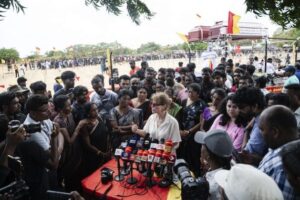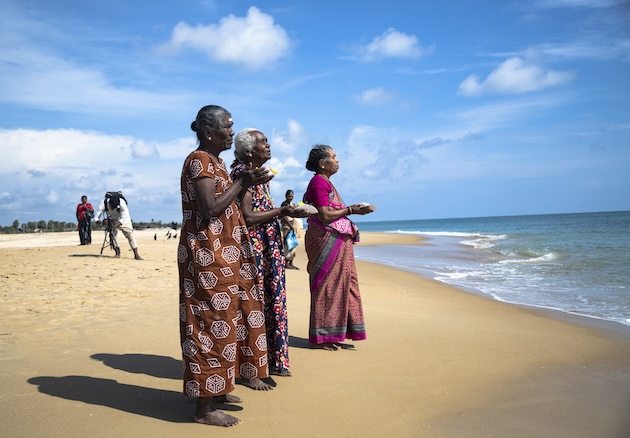
Active Citizens, Aid, Civil Society, Development & Aid, Featured, Gender, Gender Violence, Headlines, Health, Human Rights, Humanitarian Emergencies, Population, Sustainable Development Goals, TerraViva United Nations, Women’s Health

Dr. Natalia Kanem, UNFPA’s Executive Director. Credit: UNFPA
– On the heels of the Summit of the Future and the sidelines of the United Nations High-Level Meeting Week, governments and philanthropies pledged to commit at least USD 350 million to boost family planning, sexual and reproductive health and supplies on the national and global level. As enshrined in the newly-adopted Pact for the Future, seeking new international finance models is critical to solving the issues that the world faces today. The decision to pledge forward is a demonstration of commitment to ongoing health issues.
On September 24, the United Nations Population Fund (UNFPA), the Bill and Melinda Gates Foundation, Family Planning 2030 (FP2030) and the Children’s Investment Fund Foundation (CIFF) invited prominent figures across the private, development and government sectors to promote political will on the matter of sustainable investments towards sexual and reproductive health (SRH).
“Investing in reproductive health supplies is a ‘best buy’ for development, empowering women, improving maternal and newborn health outcomes, and uplifting economies,” said Dr. Natalia Kanem, UNFPA’s Executive Director.
When speaking on UNFPA’s partnerships with the co-organizers, Kanem remarked: “What we’re doing is transforming lives. The life of a girl in her community, the life of an adolescent in her city, and empowering communities and families to be able to harness and take control of their futures.”
“So much of our world has been made possible by family planning,” said Dr. Samukeliso Dube, Executive Director of FP2030. “By enabling more women to shape their lives and futures, family planning has helped women to finish their education, join the workforce, ascend to leadership positions, and achieve their dreams.”
Donor countries, such as the United Kingdom, Canada, Norway, and Spain, announced pledges to the UNFPA Supplies Partnership, which delivers modern contraceptives and maternal health supplies to women and girls in low-income countries. Through this partnership, UNFPA has helped to prevent 1.6 million child deaths, 254,000 maternal deaths, and 2.6 million unsafe abortions. The contributions to UNFPA could potentially save up to 9000 women and girls worldwide. As Anneliese Dodds, UK Minister for Development and Women and Inequalities, remarked, investing in SRH was “critical to making sure that women have the power.”
Speakers representing their countries’ governments pledged their support through domestic financial investments. The governments of Madagascar, Nepal, and the Kyrgyz Republic, for example, announced domestic financial commitments that would invest in SRH services in their countries.
Madagascar announced a contribution of USD 15 million to procure health supplies through UNFPA. Their minister of public health, Zely Arivelo Randriamanantany, added that their goal was to increase access to contraceptives by over 50 percent. Arzu Rana Deube, foreign minister of Nepal, announced the government’s commitment of USD 600,000 to purchase high-quality contraceptives. Renat Mavlyanbai Uulu, Advisor to the Minister of Health, of the Kyrgyz Republic, announced a commitment of USD 119,000 to domestic resources for family planning commodities.

Feri Anita Wijayanti, a registered midwife from Indonesia. Credit: UNFPA
As UNFPA Chief of Sexual and Reproductive Health and Rights Ayman Abdelmohsen told IPS, the commitments to domestic financing are significant; it shows that in “allocating from their own resources… and [making] budgetary allocations,” these governments will prioritize SRH without relying on foreign donors. It is in line with UNFPA’s compact agreements with 44 countries, through which countries will build up their capacity to provide comprehensive reproductive health through their own resources.
Despite the predicted growth in contraceptive access and maternal health by 2030, the current financing gap why this is still far off in the future. The gap currently sits at at least USD 1.5 billion in the world’s poorest countries.
Throughout the event, the speakers emphasized the ‘transformative’ power of SRH in countries. That to invest in SRH is to invest in girls’ and women’s’ agency over the health and life choices. In guaranteeing women’s sexual and reproductive health, it pays forward in protecting families and communities. In terms of financing, every dollar spent on family planning can yield more than 8 dollars in benefits for families and societies.
Investing in healthcare also goes forward to the practitioners within the sector. As Feri Anita Wijayanti, a registered midwife from Indonesia, explained to the panel, many communities rely on the expertise of midwives, whose responsibilities extend “far beyond delivering babies,” for they are at the frontlines to address other health issues.
“Every second in every corner of the world, midwives work tirelessly to protect the lives of women and babies, and to provide sexual and reproductive health services,” she said. Midwives have the power to save an estimated 4.3 million lives each year by 2025. We urge you to invest in us, to believe in the transformative power of midwives and to begin by investing in sexual and reproductive health.”
The commitments made by countries and the private sector are a step forward in closing the considerable financing gap. They come at a time where senior leadership within the UN, namely the Secretary-General, has called for countries to explore innovative and sustainable financing to address global inequalities. The commitments made at this event demonstrate that despite the challenges to SRH, there is political will in support of, and it can be mobilized to ensure this care for all.

















